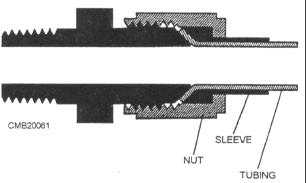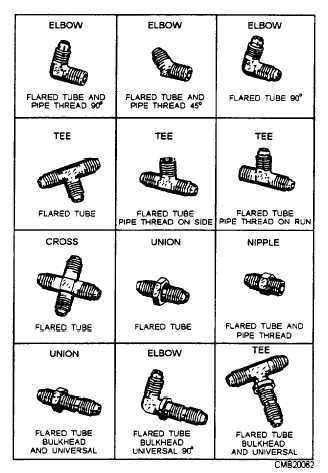To prevent seizing, you can apply a suitable pipe thread compound to the threads. When a compound is applied to the threads, the two end threads are to be kept free of the compound so that it will not contaminate the fluid. Pipe compound, when improperly applied, may get inside lines and harm pumps and control equipment. Because of this reason many manufacturers forbid the use of such compounds when fabricating the piping for a system.
Another material used on pipe thread is sealant tape, made by TEFLONTM . This tape is made of polytetraflouroethylene (PTFE), which provides an effective means of sealing pipe connections and eliminates the need of having to torque connections to excessively high values to prevent leakage. It also provides for ease in maintenance whenever it is necessary to disconnect pipe joints.
FLARED-TUBE CONNECTORS. - Flared-tube connectors are commonly used in circulatory systems consisting of lines made of tubing. These connectors provide safe, strong, dependable connections without the necessity of threading, welding, or soldering the tubing. The connector consists of a fitting, a sleeve, and a nut (fig. 3-39).
The fittings are made of steel, aluminum alloy, or bronze. The fitting used in a connection should be made of the same material as that of the sleeve, the nut, and the tubing. For example, use steel connectors with steel tubing and aluminum alloy connectors with aluminum alloy tubing. Fittings are made in union, 45- degree and 90-degree elbows, tees and various other shapes (fig. 3-40).
Tubing used with flare connectors must be flared before assembly. The nut fits over the sleeve, and when tightened, draw the sleeve and tubing flare tightly against the male fitting to form a seal. The male fitting has a cone-shaped surface with the same angle as the inside of the flare. The sleeve supports the tube so vibration does not concentrate at the edge of the flare and distributes the shearing action over a wider area for added strength. Correct and incorrect methods of installing flared-tube connectors are shown in figure 3-41. Tubing nuts should be tightened with a torque wrench to the value specified in applicable technical manuals.
FLARELESS-TUBE CONNECTORS. - The flareless-tube connector eliminates all tube flaring, yet provides a safe, strong, and dependable tube connection. This connector consists of a fitting, a sleeve or ferrule, and a nut (fig. 3-42).
Flareless-tube connectors are available in many of the same shapes and threaded combinations as flared- tube connectors (fig. 3-40). The fitting has a counterbore shoulder for the end of the tubing to rest against. The angle of the counterbore causes the cutting edge of the sleeve or ferrule to cut into the outside surface of the tube when the two are assembled.
The nut presses on the bevel of the sleeve and causes it to clamp tightly to the tube. Resistance to vibration is concentrated at this point, rather than at the sleeve cut. When fully tightened, the sleeve or ferrule is bowed

Figure 3-39. - Flared-tube connector.

Figure 3-40. - Flared-tube fittings.
Continue Reading